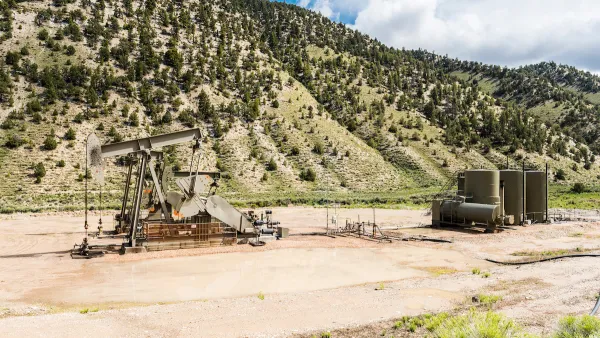A major challenge facing oil companies in the Uinta Basin is how to transport the crude to market. Alignments have been winnowed and the mode appears to be selected - rail. Total cost: $2 billion to extract $30 billion worth of oil and gas reserves.
Shale oil is associated with fracking. Mining oil shale, on the other hand, some may recall, was an expensive project undertaken by President Jimmy Carter that ended in failure. He may have been 30 years ahead of his time. Oil sands, also called tar sands, are mined in Alberta, Canada and may be transported to Gulf area refineries via the controversial Keystone XL Pipeline pending a decision by President Obama.
An oil shale project in the environmental review process is located in Utah's Uinta Basin. "After studying 26 possible routes for a rail line to transport crude oil from the Uinta Basin, the Utah Department of Transportation (UDOT) revealed Friday (June 13) that only one is feasible," writes Lee Davidson about the Uinta Basin Energy and Transportation Study.
That is a 100-mile route southwest to Price would require a 10-mile tunnel through mountains. [See map inset.] It could connect with national rail lines near Price, and take oil to Wasatch Front refineries or anywhere else in the nation to expand Utah energy markets.
Energy development would be lucrative for the state, according to the study results.
The study concluded that there is over $30 billion worth of energy development potential in the Basin. If this potential is realized, it could generate $10 billion of economic revenue and 27,000 jobs statewide over the next 30 years.
However, transport costs will be considerable, explained John Thomas, UDOT project manager for the Uinta Basin rail environmental impact statement (EIS) process. "National averages predict a construction cost of $10 million per mile for the main line, plus $100 million a mile for the tunnel — for a rough estimate of $2 billion overall."
According to a phone call with state Sen. Kevin Van Tassell, chairman of the Senate Transportation and Public Utilities and Technology Committee, a public-private type of partnership would likely finance the transport project.
Last August, Davidson's colleague, Brian Maffly, wrote about groundwater impacts described in the permitting process:
The proposed permit, which puts Utah a step closer to seeing its vast shale deposits mined on an industrial scale for the first time, would excuse Red Leaf Resources from full-scale groundwater monitoring because the company's process doesn't use water, the spent ore is dry and not much groundwater moves through the project area — a finding environmentalists dispute.
The project is not without opposition, as we noted in January.
Gaylen Webb wrote about the Springs Oil Sands project in the Uinta Basin for Utah Business in November, 2012. Earlier, the Utah Water Quality Board approved the first ever tar sands mine on U.S. soil.
FULL STORY: Wells to rails: Utah may build $2 billion line to ship oil

National Parks Layoffs Will Cause Communities to Lose Billions
Thousands of essential park workers were laid off this week, just before the busy spring break season.

Retro-silient?: America’s First “Eco-burb,” The Woodlands Turns 50
A master-planned community north of Houston offers lessons on green infrastructure and resilient design, but falls short of its founder’s lofty affordability and walkability goals.

Delivering for America Plan Will Downgrade Mail Service in at Least 49.5 Percent of Zip Codes
Republican and Democrat lawmakers criticize the plan for its disproportionate negative impact on rural communities.

Test News Post 1
This is a summary

Test News Headline 46
Test for the image on the front page.

Balancing Bombs and Butterflies: How the National Guard Protects a Rare Species
The National Guard at Fort Indiantown Gap uses GIS technology and land management strategies to balance military training with conservation efforts, ensuring the survival of the rare eastern regal fritillary butterfly.
Urban Design for Planners 1: Software Tools
This six-course series explores essential urban design concepts using open source software and equips planners with the tools they need to participate fully in the urban design process.
Planning for Universal Design
Learn the tools for implementing Universal Design in planning regulations.
EMC Planning Group, Inc.
Planetizen
Planetizen
Mpact (formerly Rail~Volution)
Great Falls Development Authority, Inc.
HUDs Office of Policy Development and Research
NYU Wagner Graduate School of Public Service



























